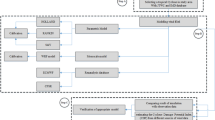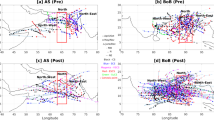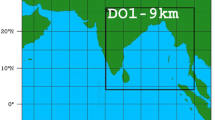Abstract
Tropical cyclone (TC) wind field monitoring and forecast are important for mariners, ships on sea and modelling group for creation of synthetic vortex, and storm surge and coastal inundation forecasting. Among others, a multi-platform satellite surface wind analysis developed by Co-operative Institute for Research in the Atmosphere (CIRA), USA for the TCs are referred by India Meteorological Department for surface wind field monitoring of TC. Hence, a study has been undertaken to analyze the characteristics of surface wind distribution and hence the structure of TC based on the real time data available from CIRA during 2007–2013. The study includes 19 TCs over the Bay of Bengal (BOB) and six over Arabian Sea (AS). The maximum radial extent of winds reaching threshold values of 34(17), 50(26) and 64(33) knot (ms−1) in each of the four geographical quadrants has been segregated with respect to season of formation, basin of formation and intensity of TC for analysis. The objective is to develop a reference surface wind structure of TC and examine its validity with respect to physical processes.
The size of outer core (34(17) knot (ms−1) wind radial extension) as well as inner core (50(26) and 64(33) knot (ms−1) wind radial extension) increases significantly with increase in intensification of TC over BOB during both pre-monsoon and post-monsoon seasons and over AS during pre-monsoon season. The outer core of winds in TCs over the BOB is asymmetric in both pre-monsoon and post-monsoon seasons and for all categories of intensity of TCs. On the other hand, the asymmetry in inner core winds is significantly less. There is also no asymmetry in radial wind extension over the AS during both the seasons, except in case of outer core wind radial extension of VSCS during pre-monsoon season. The low level environment like enhanced cross equatorial flow, lower/middle level relative humidity, vertical wind shear and proximity of TC to the land surface are the determining factors for the size and asymmetry of TCs over the NIO.













Similar content being viewed by others
References
Bessho K, DeMaria M and Knaff J A 2006 Tropical cyclone wind retrievals from the Advanced Microwave Sounder Unit (AMSU): Application to surface wind analysis ; J. Appl. Meteorol. Climatol. 45 399–415.
Chourasia Manjusha, Ashrit R G and John P George 2013 Impact of cyclone bogusing and regional assimilation on tropical cyclone, track and intensity predictions; Mausam 64 135–148.
Colon J. A, Raman C R V and Srinivasan V 1970 Tropical cyclone of May 1963 over Arabian Sea; Indian J. Meteorol. Geophys. 21 1–22.
Dean L, Emanuel K A and Chavas D R 2009 On the size distribution of Atlantic tropical cyclones; Geophys. Res. Lett. 36 L14803, doi: 10.1029/2009GL039051.
Demuth J L, DeMaria M, Knaff J A and Vonder Haar T H 2004 Evaluation of advanced microwave sounding unit tropical-cyclone intensity and size estimation algorithms; J. Appl. Meteorol. 43 282–296.
Demuth J L, DeMaria M and Knaff J A 2006 Improvement of advanced microwave sounding unit tropical cyclone intensity and size estimation algorithms; J. Appl. Meteorol. Climatol. 45 1573–1581.
Dube S K, Jisme Poulose and Rao A D 2013 Numerical simulation of storm surge associated with severe cyclonic storm in the Bay of Bengal during 2008–2011; Mausam 64 193–202.
Frank William M 1977 The structure and energetics of the tropical cyclone II. Dynamics and energetics; Mon. Wea. Rev. 105 1136–1150.
Fujibe F and Kitabatake N 2007 Classification of surface wind fields of tropical cyclones at landfall on the Japan main islands; J. Meteor. Soc. Japan 85 747–765.
Goldberg M D 1999 Generation of retrieval products from AMSU-A: Methodology and validation; 10th International TOVS Study Conference, Boulder, Colorado, 27 January–2 February.
Hill K A and Lackmann G M 2009 Influence of enviromental humidity on tropical cyclone size; Mon. Wea. Rev. 10 3294–3315.
IMD 2008 Tracks of cyclones and depressions (1891–2007), electronic version 1.0/2008; IMD, Chennai, India.
IMD 2013 Cyclone warning in India: Standard operation procedure; Published by IMD, New Delhi, India.
Jarvinen B R, Neuman C J and Davis M A S 1988 A tropical cyclone data tape for the north Atlantic basin; NOAA Tech. Memo. NWS NHC-22, 21p.
Kanamitsu M, Ebisuzaki W, Woollen J, Yang S -K, Hnilo J J, Fiorino M and Potter G L 2002 NCEP-DOE AMIP- II Reanalysis (R-2); Bull. Am. Meteorol. Soc. 83 1631–1643.
Knaff J A, DeMaria M, Molenar D A, Sampson C R and Seybold M G 2011 An automated, objective, multi-satellite platform tropical cyclone surface wind analysis; J. Appl. Meteorol. 50 2149–2166.
Knaff J A, Sampson C R, DeMaria M, Marchok T P, Gross J M and McAdie C J 2007 Statistical tropical cyclone wind radii prediction using climatology and persistence; Wea. Forecasting 22 781–791.
Kossin J P, Knaff J A, Berger H I, Herndon D C, Cram T A, Velden C S, Murnane R J and Hawkins J D 2007 Estimating hurricane wind structure in the absence of aircraft reconnaissance; Wea. Forecasting 22 89–101.
Koteswaram P and Gaspar S 1956 The surface structure of tropical cyclone in the Indian Ocean; Indian J. Meteorol. Geophys. 7 339–352.
Lee C -S, Cheung K K W, Fang W -T and Elsberry R L 2010 Initial maintenance of tropical cyclone size in the western north Pacific; Mon. Wea. Rev. 138 3207–3223.
Maclay K S, DeMaria M and Vonder Haar T H 2008 Tropical cyclone inner core kinetic energy evolution; Mon. Wea. Rev. 136 4882–4898.
Mohapatra M, Bandyopadhyay B K and Tyagi A. 2012 Best track parameters of tropical cyclones over the north Indian Ocean: A review; Natural Hazards 63 1285–1317.
Mueller K J, DeMaria M, Knaff J A, Kossin J P and Vonder Haar T H 2006 Objective estimation of tropical cyclone wind structure from infrared satellite data; Wea. Forecasting 21 990–1005.
Rappaport E N and Co-authors 2009 Advances and challenges at the National Hurricane Center; Wea. Forecasting 24 395–419.
Rao Y P 1976 “Southwest Monsoon.” Meteorol. Monogr. Synoptic Meteorol., No. 1/1976, India Meteorological Department, New Delhi, 335p.
RSMC, New Delhi 2011 Report on cyclonic disturbances over the north Indian Ocean during 2010; IMD, New Delhi, India.
Uhlhorn E W and Black P G 2003 Verification of remotely sensed sea surface winds in hurricanes; J. Atmos. Oceanic. Technol. 20 99–116.
Uhlhorn E W, Franklin J L, Goodberlet M, Carsell J and Goldstein A S 2007 Hurricane surface wind measurement from operational stepped frequency microwave radiometer; Mon Wea. Rev. 135 1370–1385.
Ueno M 2008 Effects of ambient vertical wind shear on the inner-core asymmetries and vertical tilt of a simulated tropical cyclone; J. Meteor. Soc. Japan 86 531–555.
Xu Jing and Wang Y 2010 Sensitivity of tropical cyclone inner-core size and intensity to the radial distribution of surface entropy flux; J. Atmos. Sci. 67 1831–1852.
Acknowledgements
We acknowledge CIRA, USA for providing the satellite-based wind field around the TC and NCEP/NCAR for reanalysis products online which have been used in the study. We also thank Director General of Meteorology, IMD, for providing us an opportunity to carry out this work. We are thankful to the reviewers for their valuable suggestions that improved the manuscript.
Author information
Authors and Affiliations
Corresponding author
Rights and permissions
About this article
Cite this article
Mohapatra, M., Sharma, M. Characteristics of surface wind structure of tropical cyclones over the north Indian Ocean. J Earth Syst Sci 124, 1573–1598 (2015). https://doi.org/10.1007/s12040-015-0613-6
Received:
Revised:
Accepted:
Published:
Issue Date:
DOI: https://doi.org/10.1007/s12040-015-0613-6




